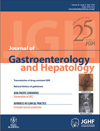The clinicopathological features of biliary intraductal papillary neoplasms according to the location of tumors
Abstract
Background and Aim: In this study, we analyzed the clinical and pathological features of biliary intraductal papillary neoplasms (IPN-B) according to the location of the tumors.
Methods: A total of 55 patients with IPN-B were analyzed. We divided them into three groups: common bile duct (CBD), hilar, and intrahepatic duct (IHD) groups. The clinical and laboratory findings, cell types, depth of invasion, malignancy, existence of stones, lymph node metastasis, recurrence, and survival rate were analyzed.
Results: There was no difference in the depth of invasion, lymph node metastasis, and coexistence of stones between the three groups. There were four different cell types; the intestinal cell type was the most common type in each group. The gastric cell type was prevalent in the IHD and hilar groups (58.3% and 33.3%, respectively). Invasive colloid carcinoma mainly showed the intestinal cell type, and tubular carcinoma showed the pancreaticobiliary cell type. There was a trend that malignancy was more prevalent in the CBD group (94.1%) than in the hilar group (64.3%) and IHD group (79.2%), but there was no statistically significant difference. There was no difference in the recurrence rate and the 3-year survival rate between the three groups.
Conclusion: IPN-B showed no difference in the malignancy and survival rates according to the location of the tumors. Because IPN-B show good prognosis after surgery, aggressive surgical resection for the treatment of IPN-B is recommended.




